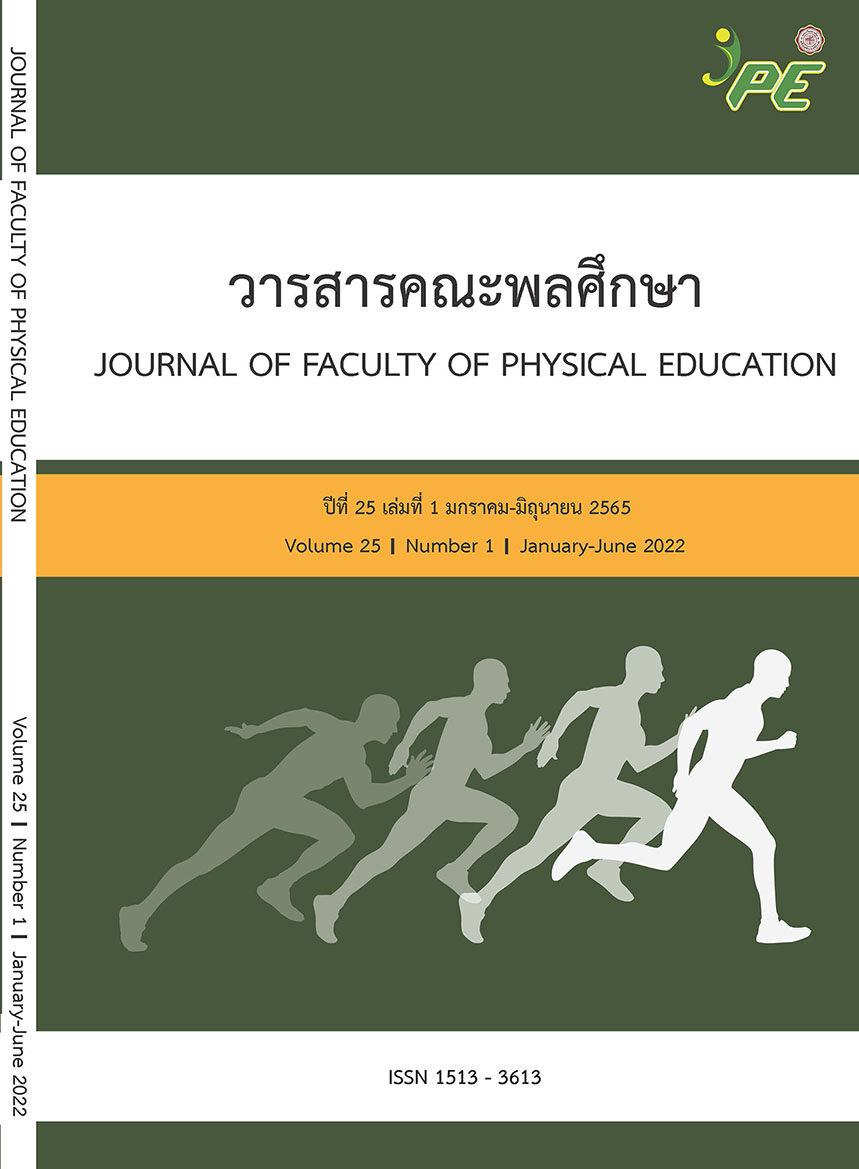Strategic Planning for the Establishment of the Faculty of Sports Industry, Thailand National Sports University
Main Article Content
Abstract
This research aimed to propose 1) the strategic plans of an establishment of The Faculty of
Sports Industry, Thailand National Sports University (TNSU), and 2) the management structures and
approaches of The Faculty of Sports Industry, TNSU. The samples consisted of two groups include:
1) 10 senior executives from sports and higher education organizations, and 20 undergraduate users.
2) 10 senior executives from Thailand National Sports University selected by purposive sampling
together with 15 faculty members and 60 students recruited through multistage sampling. The
interview form and questionnaire reviewed by 5 experts were used as research instruments. The
quality of questionnaire items was examined through the Index of Item Objective Congruence (IOC) of
0.50 or above. Data analysis was made through content analysis. PESTEL analysis was applied to
analyze the external factors that affected the establishment of The Faculty of Sports Industry, TNSU,
while SWOT analysis was used to analyze the internal factors, and TOWS Matrix was employed to
formulate strategy. Data presented by way of frequency table, percentage, mean, and standard
deviation.
Significant findings from the study were as follows:
1) The strategic plans for the establishment of The Faculty of Sports Industry, Thailand
National Sports University, comprised six primary strategies include: 1.1) Encourage the establishment
of collaboration networks in education management both in government and private sectors of the
sports industry. 1.2) Enhance faculty members’ qualities as well as teaching standards concurrently
with forming of the faculty. 1.3) Produce high-performance graduates to support the sports industry's
manufacturing and service sectors. 1.4) Create innovations based on research findings in th e sports
industry which able to generate value added to the economy and society. 1.5) Being an academicprofessional
supporter of the Sports Industry, and 1.6) Efficiency and effective management followed
the good governance.
2) The faculty management structures and guidelines comprise vision, rationale, mission,
objectives, organizational arrangement, human resource management, target output, standard and
quality control, source of income, management, and operation plans.
Article Details

This work is licensed under a Creative Commons Attribution-NonCommercial-NoDerivatives 4.0 International License.
Any articles and comments This journal is the opinion of the author. The Faculty of Physical Education doesn't always have to agree. Anyone wishing to publish or distribute a message must obtain direct permission from the author.
References
Beijing Sport University. (n.d.). Retrieved March 12, 2021 from https://en.bsu.edu.cn/.
Certo, S. C., & Peter, J. P. (1991). Strategic management: Concept and application. (2nd ed). Singapore:
McGraw-Hill.
German Sport University Cologne. (2022). Retrieved January 30, 2022 from https://www.dshskoeln.
de/english/
House of Representatives Secretariat Serving as the National Reform Steering Assembly's Secretariat.
(2016). Sports Industry Promotion. House of Representatives Secretariat Acting as the National
Reform Steering Assembly's Secretariat. Retrieved March 12, 2022 from
https://www.parliament.go.th/ewtadmin/ewt/parliament_parcy/download/
usergroup_disaster/11-4.pdf
Lithuanian Sports University. (n.d.) Retrieved March 12, 2021 from
https://studyin.lt/institutions/lithuaniansportsuniversity/.
Lydden, J. W., Mccomb, B. E. and Mizak, J. P. (2012). Tools for setting strategy. In: Howard, R. D.,
Mclaughlin, G. W. & Knight, W. E. (eds.) The Handbook of Institutional Research. San
Fransisco: Jossey-Bass.
National Sports University Act B.E. (2019). Government Gazette, 136(67), 127 – 159.
Nippon Sport Science University. (n.d.). Retrieved January 30, 2022 from https://www.nittai.ac.jp/eng/.
Office of Higher Education Policy and Planning. (2018). Long-term higher education strategy for the
next 20 years (2018-2037). Piyawang Graphics Co., Ltd.
Office of the Higher Education Commission. (2021) Commission on Higher Education Announcement
Regarding the Criteria for Establishing Internal Sections of Higher Education Institutions in the
Year 2021. Ministry of Higher Education, Science, Research and Innovation. Retrieved January
, 2022 from http://ga.kpru.ac.th/laws/uploads/1635327064.pdf
Office of the National Economic and Social Development Board. (2017). The Twelfth Edition of the
National Economic and Social Development Plan 2017–2021. Prime Minister's Office.
Office of the National Economic and Social Development Council. (2021). National reform plan
(Revised Edition) (version of the Government Gazette). Government Gazette, 138, Special
Section 44 Ngor, 1.
Office of the Permanent Secretary for Higher Education, Science, Research and Innovation. (2021).
Higher Education Plan to Produce and Develop Manpower for the Country, 2021-2027. Office
of Higher Education Policy and Planning, Ministry of Higher Education, Science, Research and
Innovation.
Office of the Permanent Secretary, Ministry of Tourism and Sports. (2017). 6th National Sports
Development Plan (2017-2021). Bangkok: Office of Printing Works of the War Veterans
Organization.
Shanghai University of Sport. (2019). Retrieved March 12, 2021 from http://sus.admissions.cn/
Shenyang Sport University. (n.d.). Retrieved March 12, 2021 from http://fao.syty.edu.cn/About_SSU.htm
Thithathan S., (2018, April 22). Thailand's 4.0 Policy and the Sports and Health Industry. Retrieved
from http://www.sportgalaxy.xyz/view/590a9837fa8c4752efa05207
Sports Authority of Thailand. (2016). Thailand's Sports Authority's Strategic Plan 2017-2021. Ministry of
Tourism and Sports
Tianjin University of Sport. (2021). Retrieved March 12, 2021 from https://school.cucas.cn/Tianjin-Universityof-
Sport-662/
Waterman, R., & Peter, T. (1980). Mc.Kinsey 7-S Framework. Retrieved March 27, 2020 from
https://www.mindtools.com/pages/article/newSTR_91.htm
Weihrich, H. (1982). The TOWS Matrix:A Tool for Situation Analysis. Long Range Planning, 15(2), 54-66.

